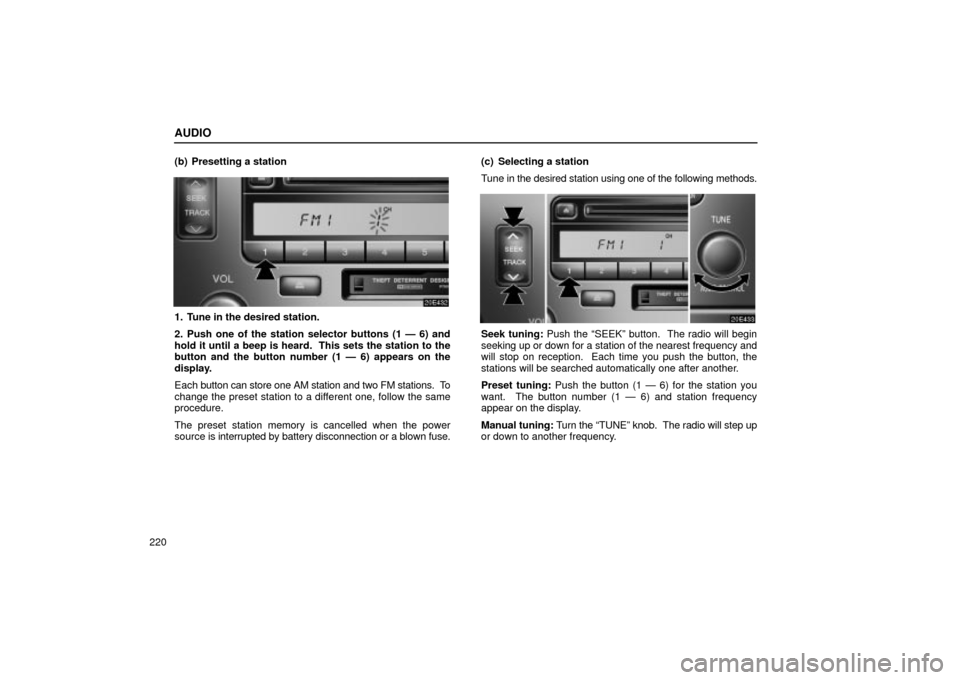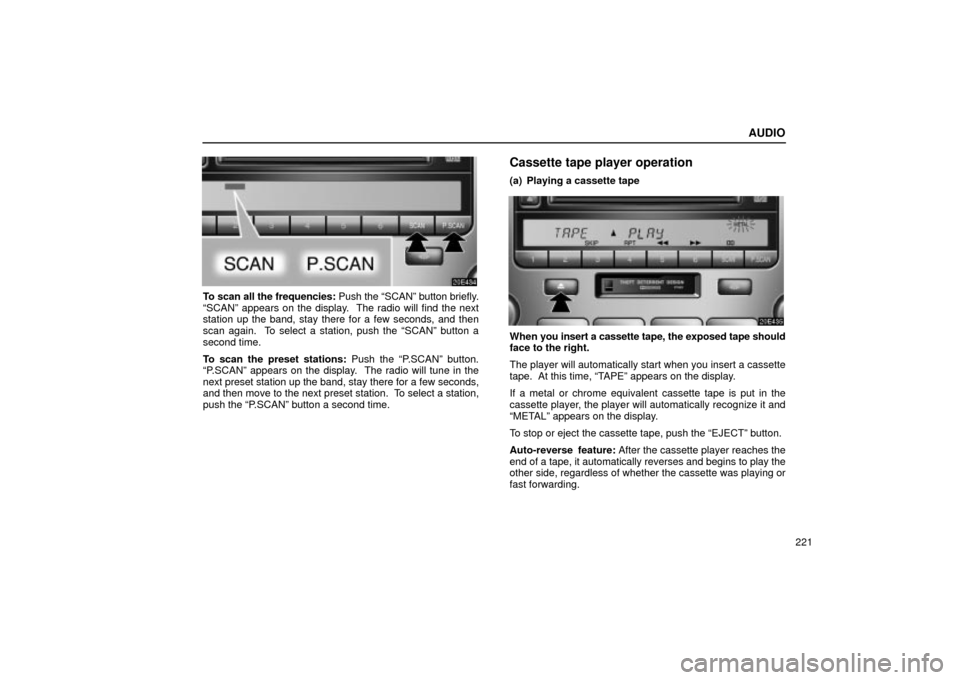Page 224 of 482

AIR CONDITIONING
199 For normal use, it is best to keep the air intake control button
set to OUTSIDE AIR mode. If recirculated air is used during
heating, the windows will fog up more easily.
If manual on-off of the air conditioning is desired Ð
Push the A/Cº button to turn the air conditioning on and push
it again to turn the air conditioning off.
The air conditioning does not work if the outside temperature
is lowered down to around 0�C (32�F).
If the system is used for ventilation, heating in dry weather or
removing frost or exterior fog on the windshield, turn the air
conditioning off once it is no longer required. This will improve
fuel economy. The air conditioning can be used for year-round
automatic temperature control including cooling and
dehumidifying operation.
If the air conditioning compressor does not operate, the
indicator of the A/Cº button will blink. If the indicator of the
A/Cº button blinks even when the A/Cº button is pushed
again, have the compressor checked by your nearest Lexus
dealer.
Displaying the outside temperature Ð
The temperature display ranges from -30�C (-22�F) up to
50�C (122�F).
(b) Windshield defogging and defrosting
To remove interior fog on the windshield Ð
Push the windshield air flow button.
To remove frost or exterior fog on the windshield Ð
1. Push the TEMPº button to set the maximum temperature.
2. Push the windshield air flow button.
3. Push the fan speed control button on the right side to obtain
a maximum air flow.
4. Leave the A/Cº button off.
When the windshield air flow button is pushed, air flows mainly
from the windshield vents and turns on the defogging function
with the purpose of clearing the front view.
Pushing this button once again returns the air flow mode to the
last one used.
Page 236 of 482
AUDIO
211
AUDIO SYSTEM (type A)
Quick reference for your audio system
20E426
�You can adjust the brightness of the display. See Instrument panel light controlº on page 68 for details.
Page 237 of 482

AUDIO
212
1Ejecting a compact disc
(See page 224 for details.)
2Function buttons
1 Ð 6:Station selector buttons
(See page 220 for details.)
SCAN:Scan tuning
(See page 221 for details.)
P.SCAN:Preset scan tuning
(See page 221 for details.)
3Display of functions in TAPE or CD mode
:DOLBY NR
(See page 222 for details.)
��:Rewinding or reversing
(See page 222 or 227 for details.)
��:Fast forwarding
(See page 222 or 227 for details.)
RPT:Automatic repeat
(See page 223 or 228 for details.)
SKIP:Automatic skip of blank portions of tape
(See page 223 for details.)
:Disc selection
(See page 226 for details.)
RAND:Random access
(See page 228 for details.)
SCAN:Scan selection
(See page 227 for details.)
4Compact disc slot
(See page 224 for details.)
5Automatic sound levelizer/Mute
(See page 214 or 216 for details.)
6TUNE/AUDIO CONTROL knob
(See page 215 for details.)
7
��:Side change
(See page 222 for details.)
8Mode selectors
(See page 215 for details.)
9Stopping and ejecting a cassette tape
(See page 221 for details.)
10Turning the system on and adjusting the volume
(See page 214 for details.)
11Cassette tape slot
(See page 221 for details.)
12Radio mode:Seek tuning
(See page 220 for details.)
TAPE mode:Direct access to a desired program
(See page 223 for details.)
CD mode:Direct access to a desired program
(See page 227 for details.)
Page 240 of 482

AUDIO
215
Push the AMº, FMº, TAPEº or DISCº button to turn on
that mode. The selected mode turns on directly.
Push these buttons if you want to switch from one mode to
another.
If the tape or disc is not set, the cassette player or compact disc
player does not turn on.
You can turn off each player by ejecting the cassette tape or
compact disc. If the audio system was previously off, then the
entire audio system will be turned off when you eject the
cassette tape or compact disc. If the another function was
previously playing, it will come on again.In the TAPEº or CDº mode, the applicable functions are
shown in the lowest part of the display. Push the switch
just below to turn on each function.
(b) Tone and balance
How good an audio program sounds to you is largely
determined by the mix of the treble, mid-range, and bass
levels. In fact, different kinds of music and vocal programs
usually sound better with different mixes of treble, mid-range
and bass.
A good balance of the left and right stereo channels and of the
front and rear sound levels is also important.
Page 241 of 482
AUDIO
216Keep in mind that if you are listening to a stereo recording or
broadcast, changing the right/left balance will increase the
volume of one group of sounds while decreasing the volume
of another.
Each time you push the AUDIO CONTROLº knob, the
display changes as in the following. To adjust the tone and
balance, turn the knob.
BAS: Adjusts low-pitched tones.
MID: Adjusts mid-pitched tones.
TRE: Adjusts high-pitched tones.
FAD: Adjusts the sound balance between the front and rear
speakers.
BAL: Adjusts the sound balance between the right and left
speakers.(c) Automatic sound levelizer
When the audio sound becomes difficult to be heard due to
road noise, wind noise, etc. during driving, the system adjusts
to the optimum volume and tone quality according to the noise
level. While the automatic sound levelizer is on, ASLº appears
on the display.
(d) Your radio antennas
The wire antenna is mounted inside the rear window.
Page 244 of 482
AUDIO
219
Radio operation
(a) Listening to the radio
Push these buttons to choose either an AM or FM station.
AMº, FM1º or FM2º appears on the display.
Turn this knob to the right to step up the station band or
to the left to step down.
Your radio automatically changes to stereo reception when a
stereo broadcast is received. STº appears on the display. If
the signal becomes weak, the radio reduces the amount of
channel separation to prevent the weak signal from creating
noise. If the signal becomes extremely weak, the radio
switches from stereo to mono reception. In this case, STº
disappears from the display.
Page 245 of 482

AUDIO
220(b) Presetting a station
1. Tune in the desired station.
2. Push one of the station selector buttons (1 Ð 6) and
hold it until a beep is heard. This sets the station to the
button and the button number (1 Ð 6) appears on the
display.
Each button can store one AM station and two FM stations. To
change the preset station to a different one, follow the same
procedure.
The preset station memory is cancelled when the power
source is interrupted by battery disconnection or a blown fuse.(c) Selecting a station
Tune in the desired station using one of the following methods.
Seek tuning: Push the SEEKº button. The radio will begin
seeking up or down for a station of the nearest frequency and
will stop on reception. Each time you push the button, the
stations will be searched automatically one after another.
Preset tuning: Push the button (1 Ð 6) for the station you
want. The button number (1 Ð 6) and station frequency
appear on the display.
Manual tuning: Turn the TUNEº knob. The radio will step up
or down to another frequency.
Page 246 of 482

AUDIO
221
To scan all the frequencies: Push the SCANº button briefly.
SCANº appears on the display. The radio will find the next
station up the band, stay there for a few seconds, and then
scan again. To select a station, push the SCANº button a
second time.
To scan the preset stations: Push the P.SCANº button.
P.SCANº appears on the display. The radio will tune in the
next preset station up the band, stay there for a few seconds,
and then move to the next preset station. To select a station,
push the P.SCANº button a second time.
Cassette tape player operation
(a) Playing a cassette tape
When you insert a cassette tape, the exposed tape should
face to the right.
The player will automatically start when you insert a cassette
tape. At this time, TAPEº appears on the display.
If a metal or chrome equivalent cassette tape is put in the
cassette player, the player will automatically recognize it and
METALº appears on the display.
To stop or eject the cassette tape, push the EJECTº button.
Auto-reverse feature: After the cassette player reaches the
end of a tape, it automatically reverses and begins to play the
other side, regardless of whether the cassette was playing or
fast forwarding.